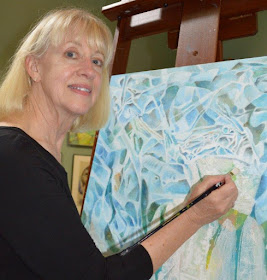An artist residency sounds promising, an opportunity to experience the peace and quiet of a country setting, bask in creative energy, and produce lots of art. However, that is what I experience every day in my studio, located in rural North Carolina. So, for my residency, I went to the big city of Atlanta.
By Pat Spainhour
Pat Spainour with a cold wax painting in progress. Photo: Paul Spainhour
Hylla introduced Evans Cold Wax Paint, by
demonstrating how to get the paint out of the tube with a crimper. There was no
instruction on how to use the paint, other than do not use heat. I started with
printmaking, as Hylla watched like an eagle, perched on a stool. I received encouragement,
questions, and praise, as I began this artistic journey. Soon it became clear,
Hylla wanted to watch me work, to see what discoveries I could make with her
paints.
Explosion, 2018, cold wax monotype, 14 x 10 inches
The prints were made by using a brayer, rolling out the
cold wax paint on a sheet of glass, manipulating the colors, and then pulling a
print. The process was exhilarating and my mind was flooded with ideas and
possibilities. I observed that drawing on the back of the paper, while still
pressed into the layer of paint, produced exciting lines. Trying to push this
concept, I worked late into the night, with the eagle watching.
Continuing the discovery, I switched to using the cold wax paint
directly onto paper, art board, and wood panels. Working with a palette knife,
I experimented with layers and drying time. Using a sgraffito technique, I
exposed layers beneath. The painting progressed quickly, as I did not need to
take time for fusing with a torch, necessary in traditional encaustic. Again,
no instruction, but Hylla was pleased with my progress.
Two cold wax paintings, both 8 x 8 inches
Above: Flow; below, Foliar
Following the residency, I continued to work with the
medium for six weeks, immersed in the quiet of the country, as I returned to North
Carolina. Working on wood panels, I used the cold wax paint as I would traditional
oil paint. I created an underpainting
using tinted encaustic gesso. Then using a soft bristle brush, an acrylic
brush, I worked to blend colors in a wet into wet technique. Although this method
of painting was time consuming, I felt the results were successful. I was satisfied
being able to achieve depth through use of highlights and shading.
Since that time, I have found ways to incorporate Evans
Cold Wax Paint into my preference of work, encaustic monotypes. Often there is
a need to complete an area on a monotype, composition wise, but I do not want
to use a heat source, which might disturb fine detail. The cold wax paint can
be used to paint into the monotype, without leaving a halo of wax, which often appears
as a grease spot. The paint, being wax based, is compatible with an encaustic
monotype, as long as this is a finishing step, and no heat is applied.
Reflecting on the experience, I enjoyed the challenge of
working in a new medium and feel that my artistry expanded. Working exclusively
with one product was exhausting, but a rewarding journey. This artist residency
challenged me to, as I often tell my students, “learn something new every day.”




No comments:
Post a Comment